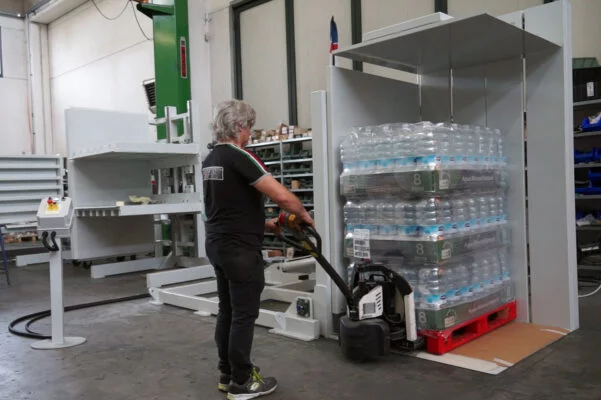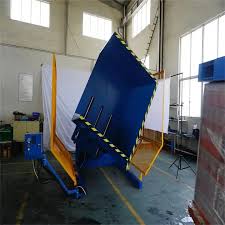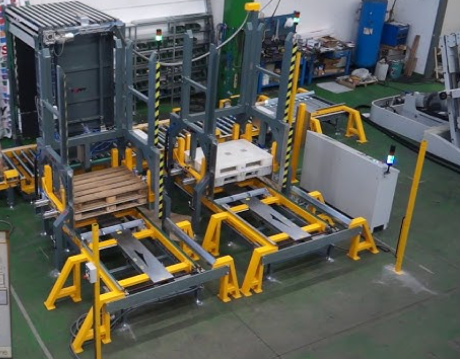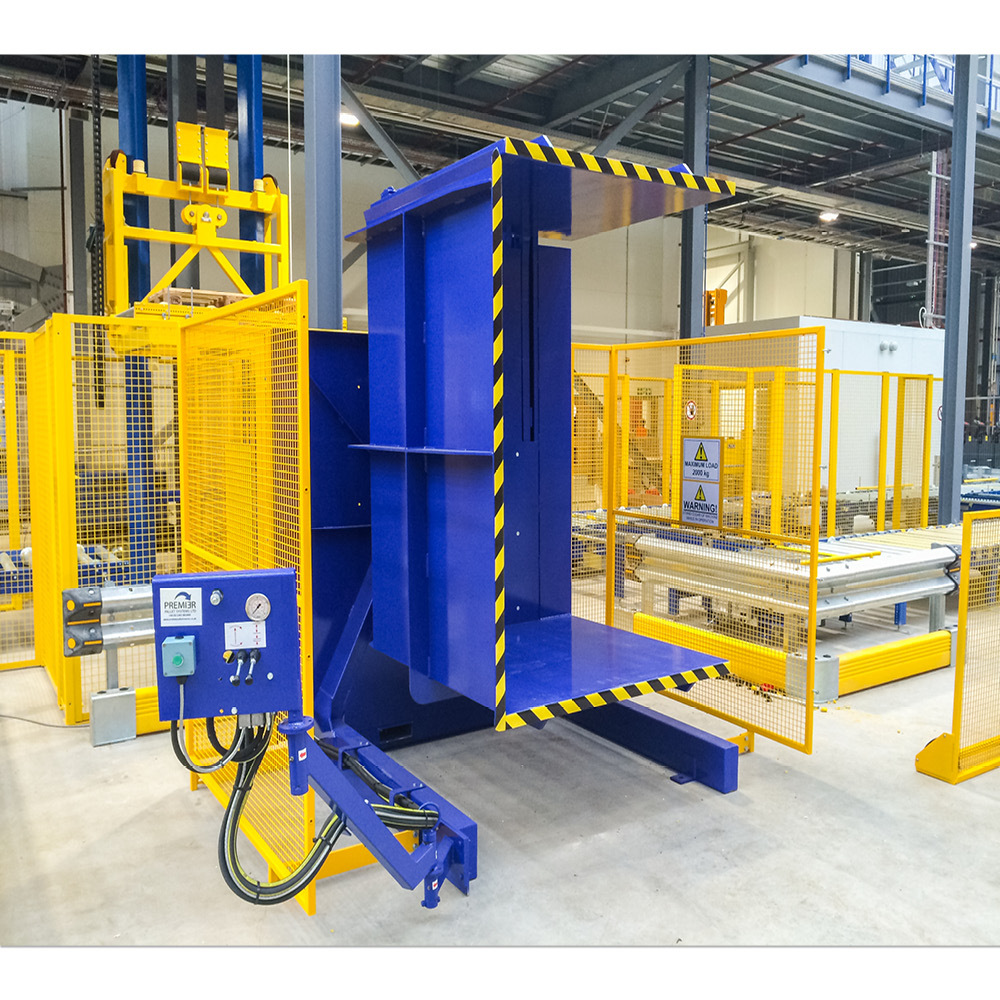Pallet Inverter: How to Maintain Safety When Changing Pallets of Toiletries?
Manually changing pallets is a ticking time bomb in any warehouse, especially when dealing with fragile and potentially messy products like toiletries. Your team is lifting heavy boxes, risking back injuries with every move. A single dropped pallet can mean hundreds of broken bottles, spilled liquids creating a slip hazard, and a significant financial loss. This isn't just a minor issue; it's a constant drain on your resources, efficiency, and employee morale. What if you could eliminate this manual, high-risk process entirely, protecting both your team and your products with one smart investment?
A pallet inverter is the key to maintaining safety during pallet changes for toiletries. It works by securely clamping the entire product load, using a controlled mechanical process to rotate it 180 degrees. This allows for the original pallet to be removed and replaced without any manual lifting of individual boxes. This method drastically reduces the risk of musculoskeletal injuries for workers, prevents product damage from drops, and contains potential spills, ensuring a safer and more efficient operation.

I've spent my entire career in the packaging and material handling industry, and I've seen firsthand how a seemingly small operational bottleneck can have huge consequences. Simply accepting manual pallet changing as "the way it's always been done" is a mistake. To truly appreciate the solution, we first need to look closely at the specific dangers you're facing every day. Then, we can explore how the right equipment and procedures transform this task from a liability into a streamlined, safe part of your workflow. Let's dig deeper.
What are the Primary Safety Risks When Manually Changing Toiletries Pallets?
You see your team working hard, moving boxes from one pallet to another. You trust them to be careful, but the reality is that every manual transfer is a risk. It's not a matter of if an accident will happen, but when. The constant physical strain, the repetitive motion, and the nature of the products themselves create a perfect storm for injuries and product loss. Think about the real costs. A single back injury can lead to months of worker's compensation claims, higher insurance premiums, and the loss of an experienced team member. A dropped pallet of shampoo isn't just messy; it's revenue literally spilled on the floor. It's time to stop gambling and start looking at the problem with clear eyes.
The primary safety risks of manually changing toiletries pallets fall into two main categories: personnel injury and product loss. For personnel, the most common issues are musculoskeletal injuries (MSDs) from lifting and twisting, slips and falls caused by spilled liquids, and cuts from box cutters or strapping. For the product, the main risks are damage from being dropped, contamination from spills, and overall loss of inventory.

The Silent Threat of Musculoskeletal Disorders (MSDs)
In my early days as an engineer, I spent a lot of time on factory floors. The most common complaint I heard was about back pain. Manually de-stacking and re-stacking a pallet is incredibly taxing on the human body. A standard box of toiletries can weigh anywhere from 10 to 20 kg. An operator might have to move 50 or more of these boxes to transfer a single pallet load. This isn't just lifting; it involves twisting and reaching, movements that put immense pressure on the spine, shoulders, and knees. Over time, this leads to chronic pain, long-term disability, and high employee turnover. An automated solution like a pallet inverter removes this physical burden entirely. The operator's job shifts from manual labor to machine supervision, a much safer and more sustainable role.
The Chain Reaction of Spills and Falls
Toiletries often come in liquid or gel form. A single dropped bottle of shampoo, conditioner, or lotion doesn't just mean a loss of that one item. It creates a slippery, hazardous surface on the warehouse floor. I once visited a facility where a minor spill led to a major accident. An employee slipped on a small puddle of spilled lotion, fell awkwardly, and broke their wrist. The incident caused a production stop, an OSHA report, and a lengthy insurance claim, all from one broken bottle. A pallet inverter contains the entire load during the transfer process. Even if a bottle is already leaking, the spill is confined within the clamped load, not on your floor where it can endanger your entire team.
Protecting Product Integrity and Your Bottom Line
Every box that is dropped, crushed, or damaged is a direct hit to your profit margin. With toiletries, the packaging is part of the product's appeal. Dented boxes or scuffed labels can make a product unsellable, even if the contents are fine. Furthermore, if a bottle breaks, the spilled contents can seep into other boxes, ruining a large portion of the pallet. This creates a quality control nightmare and can damage your relationship with retailers. A pallet inverter handles the entire load as a single, stable unit. The pressure is applied evenly, and the movement is smooth and controlled, ensuring that the products arrive on their new pallet in the same condition they started in.
| Risk Factor | Manual Handling | Pallet Inverter Solution |
|---|---|---|
| Musculoskeletal Strain | Very High (repetitive lifting, twisting) | Negligible (Operator pushes buttons) |
| Slip & Fall Hazard | High (risk of spills from dropped items) | Very Low (Process contains any potential leaks) |
| Product Damage | Moderate to High (dropping, crushing) | Very Low (Secure clamping and controlled motion) |
| Time per Pallet | 15-30 minutes | 1-2 minutes |
| Labor Requirement | 1-2 workers | 1 operator (can perform other tasks) |
How Does a Pallet Inverter Mechanize the Pallet Changing Process?
You understand the risks of manual handling and know there has to be a better way. But investing in a large piece of equipment can feel like a big step. You might wonder, "How complicated is this machine? Will my team be able to use it? How does it actually keep my products from falling out when it turns them upside down?" These are all valid questions. You worry that a complex machine will just trade one set of problems for another. The good news is that the process is remarkably straightforward and elegant. It's a solution born from sound engineering principles, designed for reliability, safety, and ease of use.
A pallet inverter mechanizes the pallet changing process by using a combination of secure clamping and controlled rotation. A forklift operator places the entire palletized load into the machine. The operator then activates two powerful clamping platforms that press against the top and bottom of the load, holding it firmly in place. The machine then rotates the entire clamped unit 180 degrees. The original pallet is now on top, where it can be easily lifted off and replaced with a new one. The process is then reversed, leaving the product perfectly stacked on the new pallet.

The Core Technology: Clamping and Rotation
Let's break this down. The magic is in the clamping mechanism. These aren't simple vises. Modern pallet inverters use hydraulic systems that provide consistent, adjustable pressure. This is critical when you're handling a variety of products. For example, a pallet of sturdy canned goods can handle more pressure than a pallet of fragile perfume boxes or plastic shampoo bottles. As an engineer, I’ve helped clients calibrate these systems perfectly. You can set the pressure so it’s strong enough to hold the load securely without any risk of crushing or damaging the packaging.
Once the load is clamped, the rotation begins. This is not a fast, jerky movement. The system uses a large, geared turntable or a cradle-like structure to ensure a smooth, stable 180-degree turn. Gravity is your friend here. As the machine rotates, the weight of the load rests securely against the platform that is now underneath it. There is no point in the process where the products are unsupported or at risk of shifting. This controlled movement is what makes it possible to invert a full pallet of liquids without any issue.
The Step-by-Step Operator Workflow
From the operator's point of view, the process is simple and safe. They are never required to touch the product itself.
- Load: The forklift driver places the pallet onto the inverter's baseplate and backs away. The operator is safely outside the machine's operational area.
- Clamp: From a control panel, the operator pushes a button to close the clamps. The machine often has sensors to automatically detect the height of the load for a perfect fit.
- Invert: The operator initiates the 180-degree rotation. The entire process is guarded by safety fencing, so no one can accidentally walk into the area while the machine is in motion.
- Exchange: With the load inverted, the original pallet is now sitting on top, at a comfortable, ergonomic height. The forklift can easily lift it off. The new pallet is then placed onto the load.
- Return: The operator rotates the load back 180 degrees.
- Unload: The clamps are released, and the forklift removes the product, now on its new pallet and ready for its next destination.
This entire sequence takes about one minute, a massive improvement in efficiency compared to manual handling.
| Machine Component | Function | Benefit for Toiletries Handling |
|---|---|---|
| Fork Pockets / Loading Platform | Allows easy loading and unloading with a standard forklift. | Streamlines the process, integrates with existing equipment. |
| Adjustable Hydraulic Clamps | Secure the top and bottom of the load with controlled pressure. | Prevents crushing of plastic bottles and delicate cardboard packaging. |
| 180-Degree Turntable/Rotator | Smoothly inverts the entire clamped load. | Eliminates manual lifting and prevents product shifting or damage. |
| Operator Control Panel | Centralized push-button controls for all machine functions. | Keeps the operator at a safe distance from moving parts. |
What Key Safety Features Should You Look for in a Pallet Inverter?
You're convinced that a pallet inverter is the right direction for your operation. But a quick search reveals many different models and manufacturers. How do you choose the right one? Buying a machine without the proper safety features is like buying a car without seatbelts or airbags. You might be solving the problem of manual lifting, but you could be introducing new mechanical or electrical hazards. A cheap machine that cuts corners on safety is not a bargain; it's a liability waiting to happen. I have seen clients make this mistake, and it always costs more in the long run.
When evaluating a pallet inverter, you must prioritize non-negotiable safety features. The most critical components are a complete perimeter guarding system with access control like light curtains, multiple and easily accessible emergency stop (E-stop) buttons, an intelligent clamping system with adjustable pressure control, and clear provisions for lock-out/tag-out (LOTO) during maintenance. These features are the difference between a simple machine and a truly safe, industrial-grade solution.

Perimeter Guarding is Non-Negotiable
The single most important safety feature is physical guarding. A pallet inverter is a powerful piece of machinery. The operational area must be completely enclosed with high-strength safety fencing. This prevents anyone from accidentally walking into the path of the rotating or clamping machine. But a fence alone is not enough. The access point, where the forklift loads and unloads, needs to be protected. The gold standard for this is a light curtain. This is a photoelectric safety device that creates an invisible infrared barrier. If any object—a person, a forklift mast, a stray pallet—breaks this beam while the machine is active, it will instantly stop all motion. It’s a failsafe system that provides the highest level of protection for your team.
Intelligent Clamping for Product and People Safety
We've talked about adjustable clamping pressure to protect your products. This is also a safety feature. A system that can crush your product is a system that can cause serious injury. Look for a machine with a reliable, easy-to-use pressure regulator gauge. The operator should be able to clearly see and set the pressure for each type of load. Advanced systems can even store presets for different SKUs, reducing the chance of human error. Additionally, the system should have a failsafe. If the machine loses power, the hydraulic clamps should be designed to maintain pressure, ensuring the load is not dropped. I always advise my clients to test this during the machine commissioning.
Emergency Stops and Maintenance Safety (LOTO)
In any emergency, your team needs to be able to stop the machine instantly. Look for large, red E-stop buttons placed in multiple, easy-to-reach locations around the machine—on the control panel, near the loading bay, and on the opposite side. It should be obvious and instinctive to use. Beyond emergencies, you need to plan for safe maintenance. The machine must have clear lock-out/tag-out (LOTO) points. This means a qualified technician can completely isolate the machine from its power source (electrical and hydraulic) and lock it out before performing any service. This prevents any possibility of the machine starting up unexpectedly while someone is working on it. This isn't just a good idea; it's a legal requirement in most countries and a cornerstone of any serious industrial safety program.
| Safety Feature | Description | Why It's Essential |
|---|---|---|
| Full Perimeter Fencing | A physical cage or fence surrounding the machine's entire operational area. | Prevents personnel from accidentally entering the danger zone. |
| Light Curtain/Safety Gate | An infrared safety beam at the entrance. Breaking the beam stops the machine. | Provides active protection at the loading/unloading point. |
| Adjustable Pressure Control | A hydraulic regulator that allows setting the maximum clamping force. | Protects fragile products like toiletries from being crushed. |
| Multiple E-Stop Buttons | Prominently placed buttons that immediately cut all power to the machine. | Allows for a quick shutdown from any position in an emergency. |
| Lock-out/Tag-out (LOTO) | A system to completely de-energize and secure the machine for maintenance. | The ultimate safety protocol to protect maintenance staff. |
How Do You Implement a Safe Operating Procedure for a Pallet Inverter?
You've done your research and invested in a top-quality pallet inverter with all the right safety features. The machine arrives and is installed on your factory floor. Is your work done? Absolutely not. I've learned over my career that the best safety hardware in the world can be defeated by a lack of training or poor procedures. A machine is ultimately a tool, and its safety depends on the person using it. Believing that the machine alone will solve all your problems is a recipe for failure. You risk seeing your team develop unsafe shortcuts, bypass safety features, or operate the machine incorrectly, potentially leading to the very accidents you invested in the equipment to prevent.
To make a pallet inverter a true safety asset, you must develop and enforce a comprehensive Safe Operating Procedure (SOP). This isn't just a document; it's a system. It involves providing thorough, certified training for all operators, creating a clear and visual step-by-step guide posted at the machine, establishing a strict schedule for routine inspections and preventative maintenance, and controlling access to ensure only trained and authorized personnel can operate the equipment.

Training: The Foundation of Safety
The first step is always training. This should not be a quick 10-minute overview. The manufacturer or their certified representative should provide in-depth training for a select group of operators and a maintenance lead. This training must cover more than just the "start" and "stop" buttons. It should include:
- A detailed walkthrough of every machine component and safety feature.
- The proper procedure for loading and unloading different types of products.
- How to correctly set the clamping pressure for different loads.
- How to recognize common error codes or faults and who to call for help.
- A full simulation of emergency procedures, including using the E-stops.
- The complete lock-out/tag-out procedure for maintenance.
Every employee who completes this training should be certified, and records should be kept. I also strongly recommend annual refresher courses to ensure best practices are maintained.
The SOP Document: Clarity and Accessibility
Your SOP should be a simple, clear, and easy-to-follow guide. Avoid technical jargon. Use bullet points, large fonts, and even pictures or diagrams. This document should be laminated and permanently posted at the operator's control station. It should include a pre-operation checklist that the operator must run through at the start of every shift.
- Pre-Operation Checklist:
[ ]Area around the machine is clean and clear of obstructions.[ ]Safety guards and fences are secure and in place.[ ]Light curtain is active and has been tested.[ ]No visible signs of hydraulic fluid leaks.[ ]E-stop buttons are clear and accessible.
This simple checklist takes 30 seconds but can prevent a major incident.
Maintenance: From Reactive to Proactive
A safe machine is a well-maintained machine. Your SOP must include a maintenance schedule. This moves you from fixing things when they break to preventing them from breaking in the first place. This proactive approach is far safer and more cost-effective.
- Daily: Operator visual inspection (using the checklist).
- Weekly: A lead operator or maintenance person should test the function of the light curtains and all E-stops. They should check hydraulic fluid levels and look for any unusual noises during operation.
- Quarterly/Annually: A certified technician should conduct a thorough inspection of all high-wear parts like hydraulic hoses, chains, sprockets, and electrical connections.
All of this activity should be recorded in a maintenance logbook kept with the machine. This creates a history of the machine's health and demonstrates your company's commitment to safety.
| Procedure Element | Goal | Key Actions |
|---|---|---|
| Operator Training & Authorization | Ensure only competent individuals operate the machine. | Certified training, access control (key or code), keep records. |
| Visual SOP Document | Provide clear, step-by-step instructions at a glance. | Use checklists, pictures, and simple language. Post at the machine. |
| Pre-Use Inspection | Catch potential issues before they become hazards. | Operator performs a quick check at the start of every shift. |
| Preventative Maintenance Schedule | Maintain machine integrity and reliability. | Logged daily, weekly, and quarterly inspections and service. |
Conclusion
A pallet inverter is more than a machine; it's a comprehensive safety system that protects your people, your products, and your profits when it is implemented with care.
My Insights
You might be reading this and thinking, "Vincent, this is good information, but I run a steel mill, not a toiletries warehouse." You are right. But the fundamental principles we've discussed are universal. Whether you are handling a pallet of shampoo bottles or a coil of steel wire, the core challenges for a business leader like you, Javier, are the same.
The real conversation is not about the specific product. It's about a strategic approach to your challenges: aging equipment, cost pressures, and the need for higher efficiency. When I look at a pallet inverter, I don't just see a machine that turns things upside down. I see a tool that directly attacks your biggest goals.
It addresses your goal to increase capacity utilization. By cutting a 20-minute manual process down to 2 minutes, you eliminate a major bottleneck. This improves flow and helps you get closer to that 95% effective run time.
It helps you lower operating costs. You reduce labor costs for the task, but more importantly, you eliminate the massive, unpredictable costs of workplace injuries and damaged products. This is a direct path to improving your overall profit margin.
Finally, it’s a step toward digitalization and automation. A modern pallet inverter is a smart machine. It has sensors and controls that can be integrated into a larger MES. It’s a foundational piece of building a safer, more automated, and more data-driven factory.
This is why I founded SHJLPACK on the principle of being a strategic partner, not just a supplier. A true partner understands that you aren't just buying a piece of steel. You are investing in a solution to a business problem. The conversation should always start with your goals—like reducing energy consumption or improving safety—not with my machine catalog. Whether it's a pallet inverter or a coil packing line, the goal is the same: to provide a total solution that makes your business stronger, safer, and more profitable.



